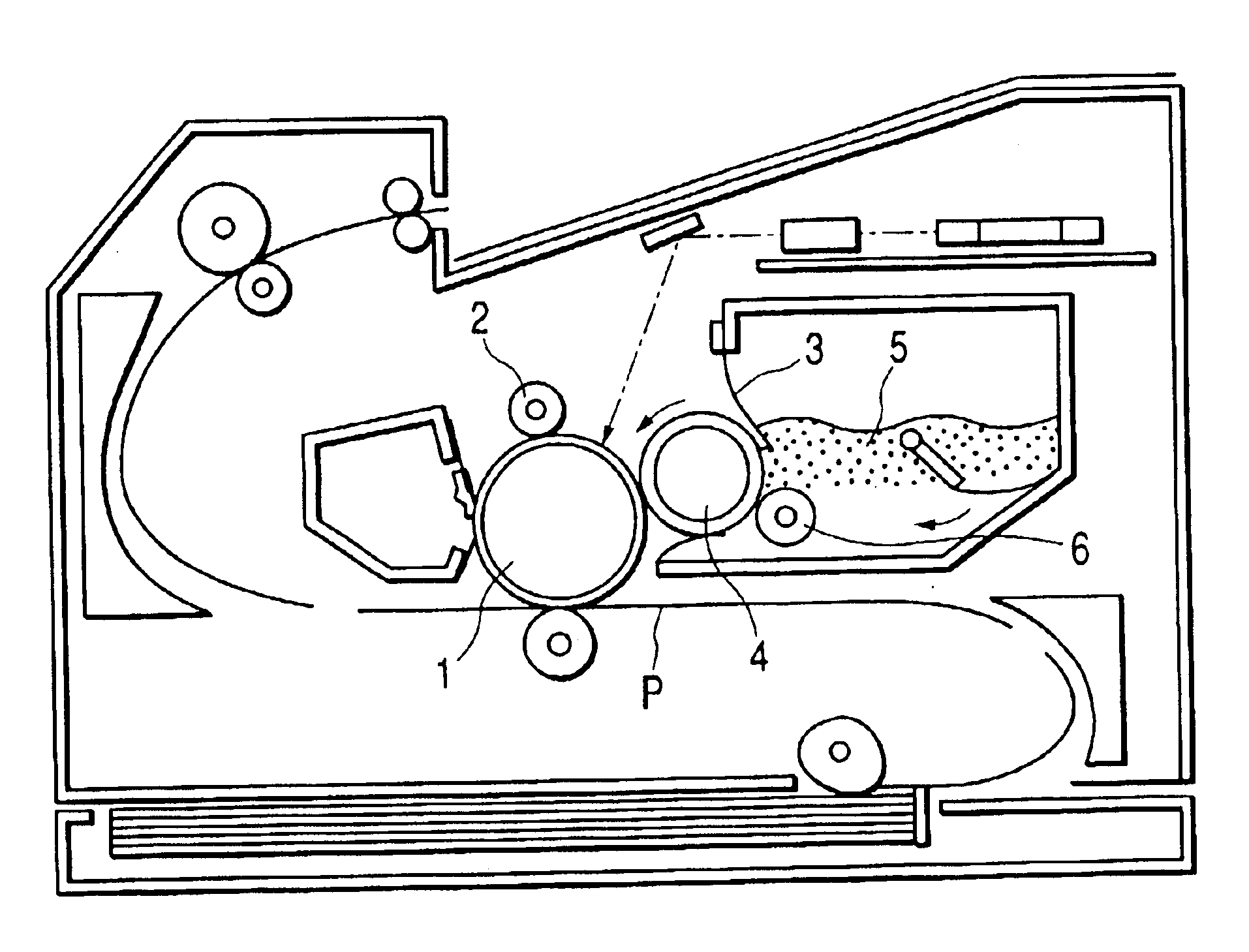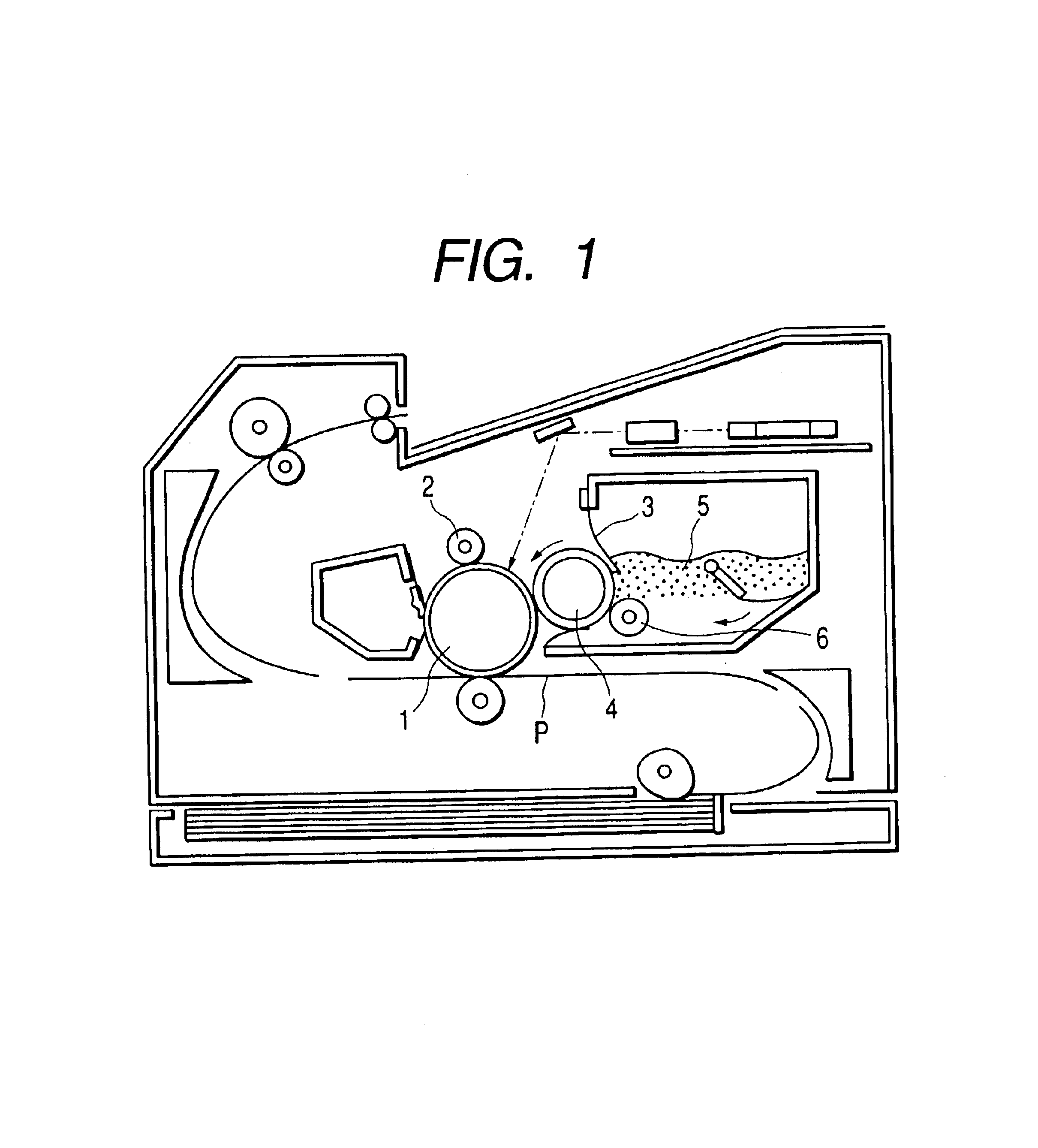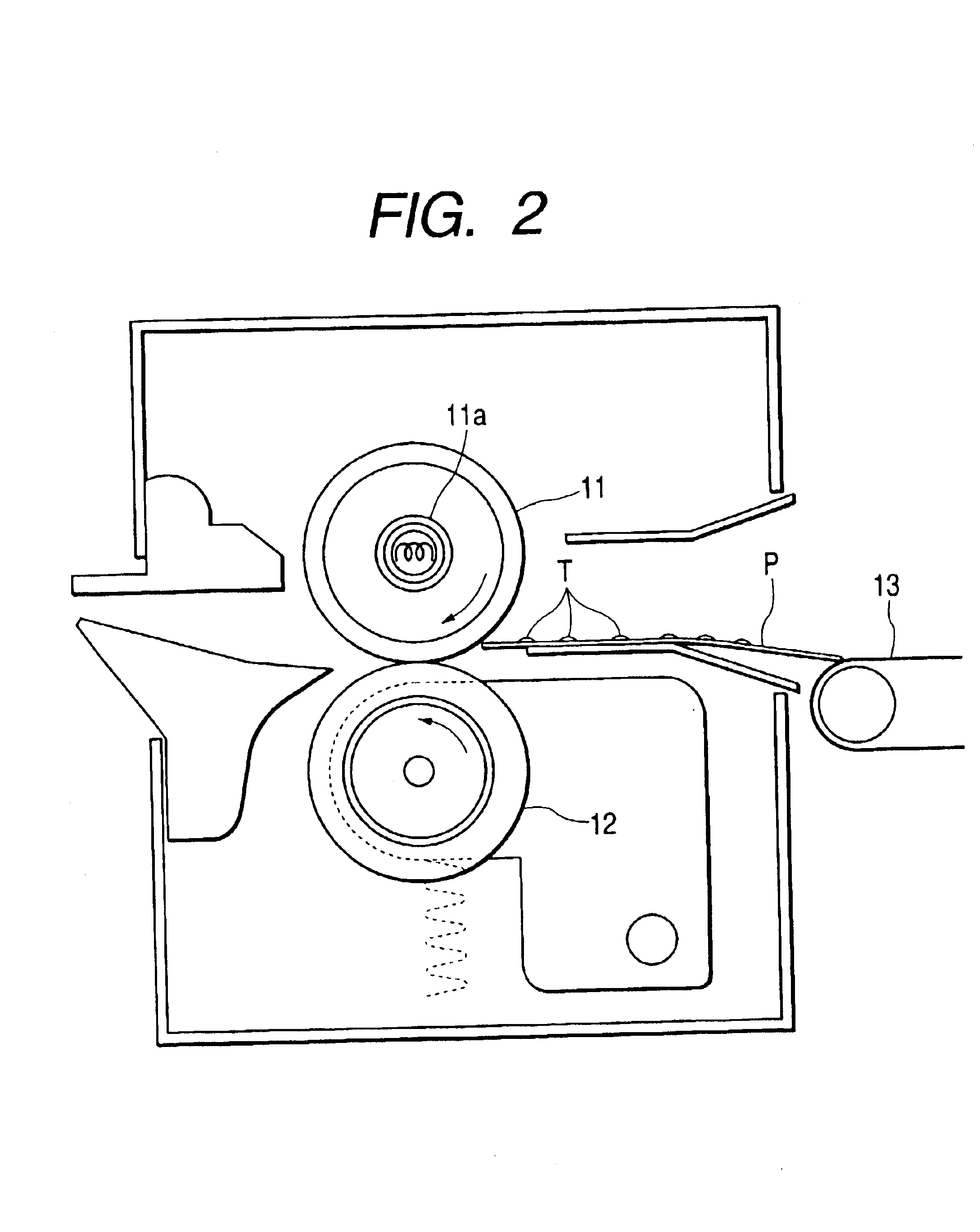However, it has turned out that toner particles having a high
sphericity have a small specific surface area so as to make a colorant stand poorly dispersed in the interiors of toner particles to greatly affect their transfer performance or matching for the transfer
assembly.
Where images are formed at a higher speed, such a fixing roller requires a large quantity of
heat energy instantaneously while applying a
high pressure.
This causes an undesirable situation that the fixing
assembly must be made large-sized or its pre-
heating time must be set longer.
However, such toners having good sharp-melt performance commonly have so high affinity for the fixing roller as to tend to cause an offset phenomenon that the toner transfers to the fixing-roller surface at the time of fixing.
Too high fixing temperature makes the toner have too low
viscosity, and hence a toner layer tends to transfer to the fixing-roller surface.
Too low fixing temperature makes the toner melt insufficiently, so that the toner can not melt into the transfer material surface to tend to transfer to the fixing-roller surface.
However, difficulties may arise such that (1) since a unit for feeding the offset-preventive liquid is required, the fixing
assembly may become complicated to provide a factor of obstruction in designing compact and inexpensive image-forming apparatus; (2) the offset-preventive liquid applied may be permeated into the fixing roller at the time of heating to trigger any peeling at the interface of
layers and consequently shorten the lifetime of the fixing roller; (3) since the offset-preventive liquid adheres to the fixed image obtained, a feeling of stickiness may be given and, especially when transparency films utilized in overhead projectors as a means for presentation are used as transfer materials, their transparency may be damaged so that the desired
color reproduction cannot be achieved; and (4) the offset-preventive liquid may contaminate the inside of the image-forming apparatus.
The influence of such transfer materials on fixing assemblies is so great as to make it difficult to make them compact or long-lifetime.
A problem has also arisen such that any contaminants coming from transfer materials and the toner are made into lumps to stick fast to the fixing-roller surface to cause a lowering of the performance of the fixing assembly, or that the matter having stuck may be released to damage the quality of fixed images.
However, the regenerated paper often contains various adultalants or impurities.
It is predicted that its mixing proportion increases more and more in future, and it is apprehensive that this may cause the above problems.
In addition, where a cleaning member for removing toner and so forth having adhered to the surface of the heating roller or a separation member for preventing transfer materials from winding around the roller is provided, it has been ascertained that the surface of the fixing roller may be scratched or abraded or the function of the cleaning member or separation member may greatly lower, because of mechanical-paper type pulp fibers contained in
paper dust desorped from, in particular, regenerated paper made from mechanical
waste paper such as newspaper and
magazine waste paper.
Such a phenomenon tends to cause a serious question when using a fixing assembly in which the offset-preventive liquid is applied on the fixing roller in a small quantity or a fixing assembly in which any offset-preventive liquid is not applied.
As stated above, the application of the offset-preventive liquid on the fixing-roller surface of the fixing assembly is very useful, but on the other hand has various problems.
In that case, filming on the photosensitive member or
contamination of carrier surface or developer-carrying member surface may occur to cause new problems such as image deterioration.
When transparency films are used as transfer materials especially in forming full-color images, the fixed images may have poor transparency or
haze because of high
crystallization of the
wax component or difference in
refractive index from binder resins.
This problem has remained unsolved.
If, however, the
wax is merely incorporated in toner particles, it is difficult to highly improve various properties required for toners, and the matching for image-forming apparatus making use of the heat-and-pressure fixing
system can not be satisfactory.
However, it is not the case that these colorants fulfill all the conditions required for
magenta toners.
It has also been necessary to take into account such a problem that any good negative chargeability can not be achieved because of charge characteristics of colorants used and hence the toner may scatter from the developing assembly to adhere to, and contaminate, the inside of the image-forming apparatus.
The above yellow dyes commonly have superior transparency, but have inferior light-fastness, and may cause not only a problem on storage stability of images but also a problem on the combination with image-forming apparatus.
On the other hand, the above yellow pigments commonly have superior light-fastness as compared with the yellow dyes, but have room for improvement in respect of the state of dispersion in toner particles, and hence have a problem that image
fog due to poor charging performance may occur.
Yellow pigments having superior light-fastness or
heat resistance may also commonly make toners have so extremely low transparency that OHT (overhead
projector transparency film) projected images tend to have a dullness.
The toners making use of the above pigments, however, can by no means be said to have good transparency, and have not been designed also taking account of fixing performance.
However, making fine the
pigment classified as C.I.
Pigment Yellow 180 may inevitably result in a great lowering of negative chargeability of the
pigment itself.
Toners making use of such a
pigment have caused a new problem of lack of charge quantity, in particular, lack of charge quantity in an environment of high temperature and
high humidity.
The above colorant is also so strongly self-agglomerative that it may disperse with difficulty in a good state in the binder resin included in the toner.
Hence, there has been a tendency of showing inferior OHT transparency.
In addition, as a result of studies made by the present inventors on fixing performance of toners containing the colorants mentioned above, it has been found that a tendency of narrowing the fixable-temperature range is seen or image peeling tends to occur.
As having been discussed above, there has not yet been any sufficient measure to generally deal with the
system designing of image-forming apparatus making use of the heat-and-pressure fixing
system, taking even the developing system into account including colorants used in toners.
In particular, under the eristing circumstances, the above
magenta toner and yellow toner, inclusive of their secondary colors, have not yet reached any sufficient level in respect of the transparency and so forth.
 Login to View More
Login to View More 


